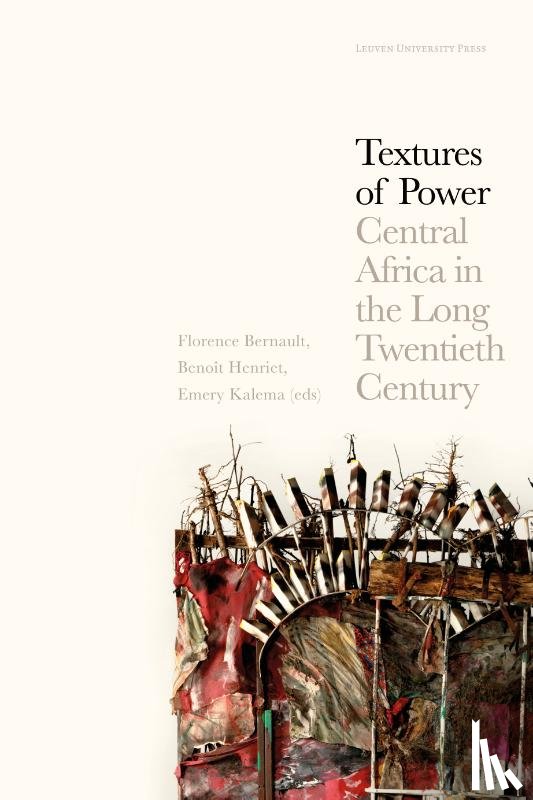Omschrijving
A multidisciplinary study of power in Central Africa Central Africa has long been a fertile ground for engendering new concepts and innovative research, exerting significant influence on African studies and beyond. This edited volume offers groundbreaking, multidisciplinary reflections on power in Central Africa, from the Atlantic slave trade era to the present. By bringing together emerging and leading scholars, *Textures of Power* builds on the rich epistemic legacies of (Central) African studies, and opens new research avenues across history, anthropology, and cultural and political studies. It offers fresh perspectives on colonial and postcolonial power structures, drawing on new findings while critically engaging with earlier theoretical frameworks.
Employing the concept of “texture” as a red thread, the book showcases the central importance of power as an analytical tool in the humanities and the social sciences. It fosters dialogues between emotions and technology, colonialism and its aftermath, and between non-humans and the invisible world. Drawing on stories about women, social rebellions, digital technologies, slavery, languages, forest management, charms, care and bio-medicine, urban life, radio, music, witchcraft, homosexuality, and environmental pollution, this volume emphasizes bottom-up, long-term and emic approaches as well as local theories about power.
This work will appeal to students and scholars in African studies, colonial and postcolonial studies, and those interested in Africa’s longue durée history. Beyond its spatial focus, it will also be relevant to those studying power dynamics, cultural studies, queer and gender studies, and environmental humanities. Acknowledgements
A Note on the Book’s Cover: Thornton Dial’s ‘History Refused to Die’ (2004)
Introduction
Florence Bernault, Benoît Henriet, Emery Kalema
Part 1. Long-Term Imaginations and Languages of Power
Chapter 1.1. The Power of Motherhood and Wealth: Ugandan Concepts in the Common Era
Rhiannon Stephens
Chapter 1.2. From Hauling to Harrowing : Resilience and Change in Moral Imaginations of ‘Slavery’ in the Southern Lower Congo (700 BCE – ca. 1880s)
Marcos Leitão de Almeida
Chapter 1.3. The Powers of Objects and the Collapse of Lunda (Angola and Western DRC), 1850-1900
David M. Gordon
Chapter 1.4. The Power of Between : Political Power of the Bangando Community, Southeastern Cameroon
Stephanie Rupp, Philippe Ambata, Stephane Molong, Abel Mungoie
Part 2. Weaving and Tearing out Textures of Power in Colonial and Postcolonial Times
Chapter 2.1. A Transgressive Economy : Revolt, Repurposing, and Redistribution in 1931 Belgian Congo
Benoît Henriet
Chapter 2.2. ‘Strange Men Who Call Themselves Chiefs’ : The Practice of Power and Authority Among the Acholi of Northern Uganda
Patrick Otim
Chapter 2.3. The Tension From Within : Soldiers and Administrators Disputing Power in Late Colonial Guinea-Bissau (1961-74)
Pedro Cerdeira
Chapter 2.4. Governing the Living Through the Dead : Necropower in a Post-Disaster Context in Cameroon
Brice Molo
Chapter 2.5. The Out-of-Self Sovereignty of the Dark Continent
Joseph Tonda
Part 3. Spatial Technologies
Chapter 3.1. More Than Meets the Eye : Colonial Violence and Spatial Imaginaries of Power in South-Ubangi, DR Congo
Margot Luyckfasseel
Chapter 3.2. Policing the Colonial City : Urban Planning and the Politics of Order in the Port City of Matadi, DR Congo, 1928-1960
Johan Lagae, Jacob Sabakinu Kivilu (†)
Chapter 3.3. Building Walls, Arranging Rooms : Values and Designs in Prisons of the Belgian Congo, 1908-1960
Valentine Dewulf
Chapter 3.4. Textures of Power in Kinshasa Prison : Regulation by Violence and Mafia-Style Arbitrariness
Sylvie Ayimpam, Jacky Bouju, Michel Bisa Kibul
Part 4. Gender, Sexualities, and Bodily Politics
Chapter 4.1. Engendering Domestic Space : Polygamy, Witchcraft, and Power Dynamic in the Mandara Mountains
Melchisedek Chetima
Chapter 4.2. The Language of Syphilis in Colonial Uganda
Neil Kodesh
Chapter 4.3. Homosexuality, Queer Politics, and the Texture of Power in Cameroon
Basile Ndjio
Chapter 4.4. Congolese Regimes and Lumumba’s Politics of Life
Emery Kalema
Part 5. The Other Side: Mystical and Nocturnal Power
Chapter 5.1. Witchcraft as an Archive : Aquatic Murders, Metamorphosis Forces, and Historical Narratives in the Central African Republic
Andrea Ceriana Mayneri
Chapter 5.2. When ‘Slaves’ are Kept in a Bundle : Reliquary Art, Power and Slavery in Southwestern Gabon and the Republic of Congo
Maxime de Formanoir
Chapter 5.3. Dark Capital and the Power of Containers
Florence Bernault
Chapter 5.4. Beyond Syncretism: The History of Tangled Powers in Congo- Brazzaville
Fred O. Biyela
Chapter 5.5. The Fabric of Conspiracy Narratives: Freemasonry as Anusocratie, Cameroon
Rogers Orock, Peter Geschiere
Part 6. Connectivities of Power
Chapter 6.1. The Musical Afterlives of the Kongo Kingdom : Music and Power Between Cuba and Central Africa in the Twentieth Century
Charlotte Grabli
Chapter 6.2. ‘Changwe Yetu’ : Theatre as a Site of Encounters of Power on the Congolese Copperbelt
Enid Guene
Chapter 6.3. Radio and Dictatorship in Idi Amin’s Uganda
Derek R. Peterson
Chapter 6.4. The Timbre of Power in Burundi
Aidan Russell
Chapter 6.5. Music Technologies of Power in Gabon
Alice Aterianus-Owanga
Chapter 6.6. Digital Horizons, Cryptopolitical Agency, and Shifting Elsewheres in the Kinois Imagination in the Early Twenty-First Century
Katrien Pype
Part 7. Beyond the Human
Chapter 7.1. Weaving the Future: Duiker Hides Trade and the Aka in Colonial Central Africa
Etienne Gontard
Chapter 7.2. The Power of Pollution on the Central African Copperbelt
Iva Peša
Bibliography
List of contributors
Index


